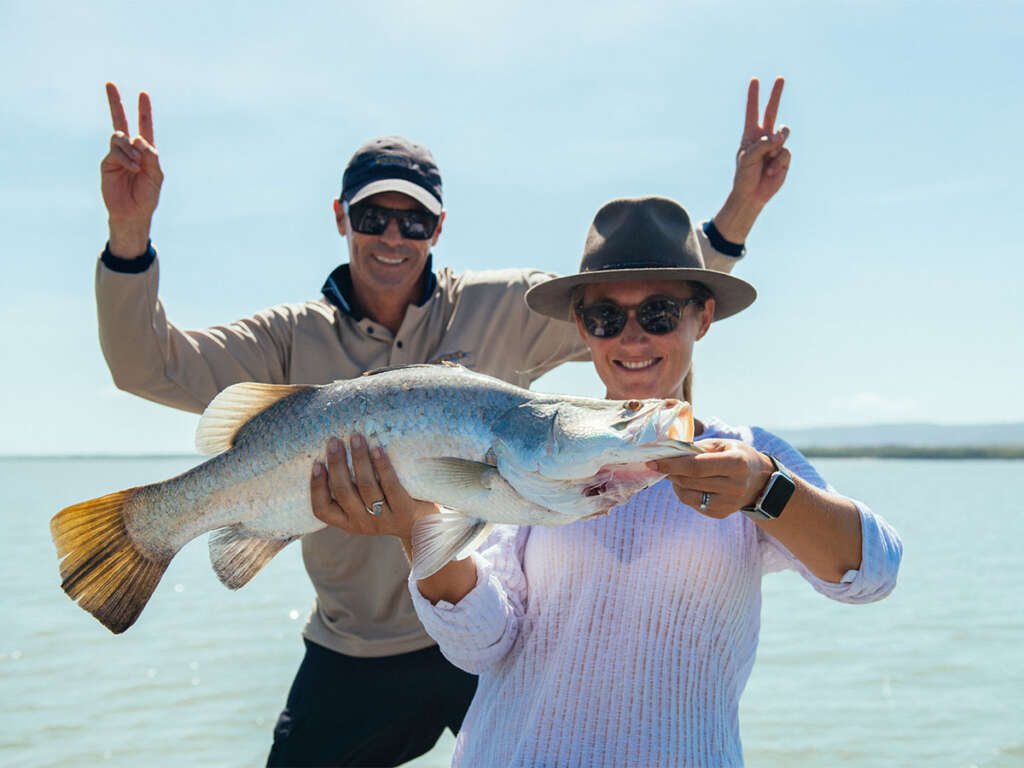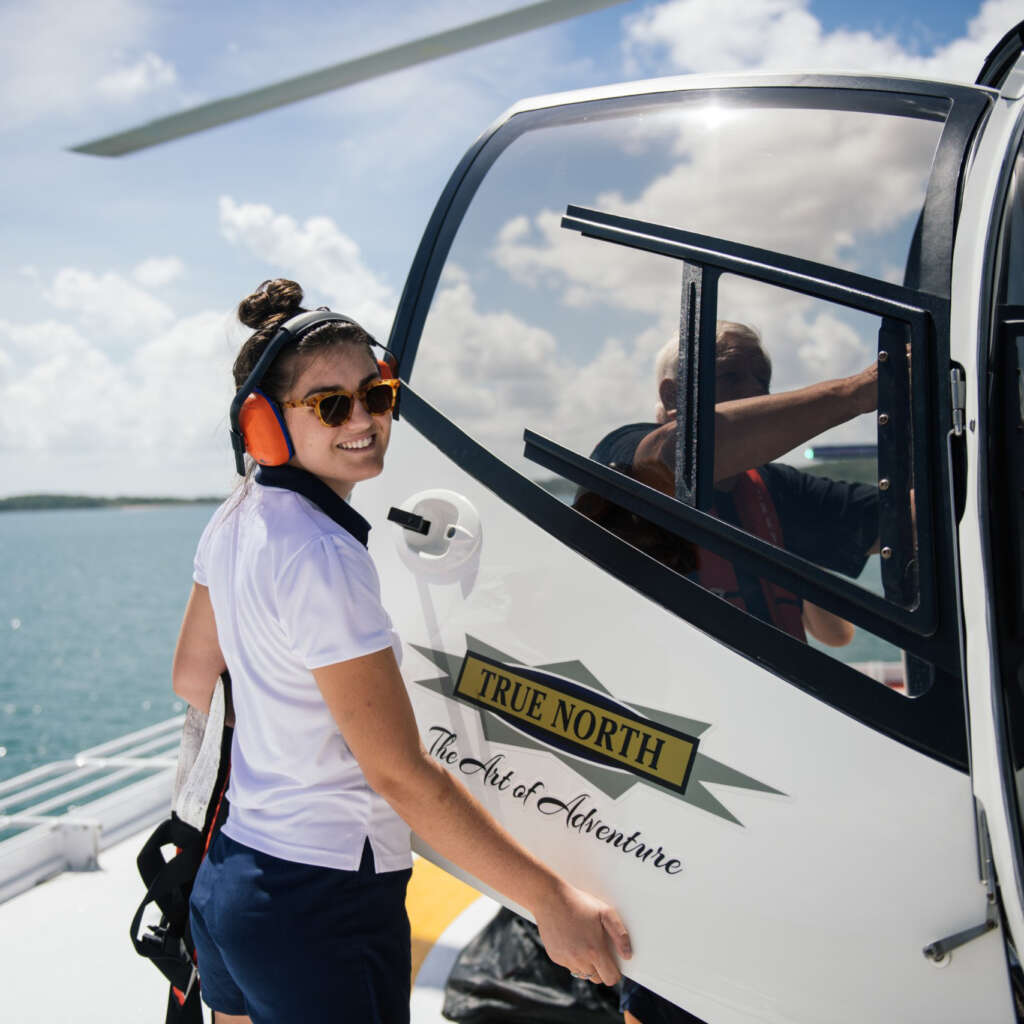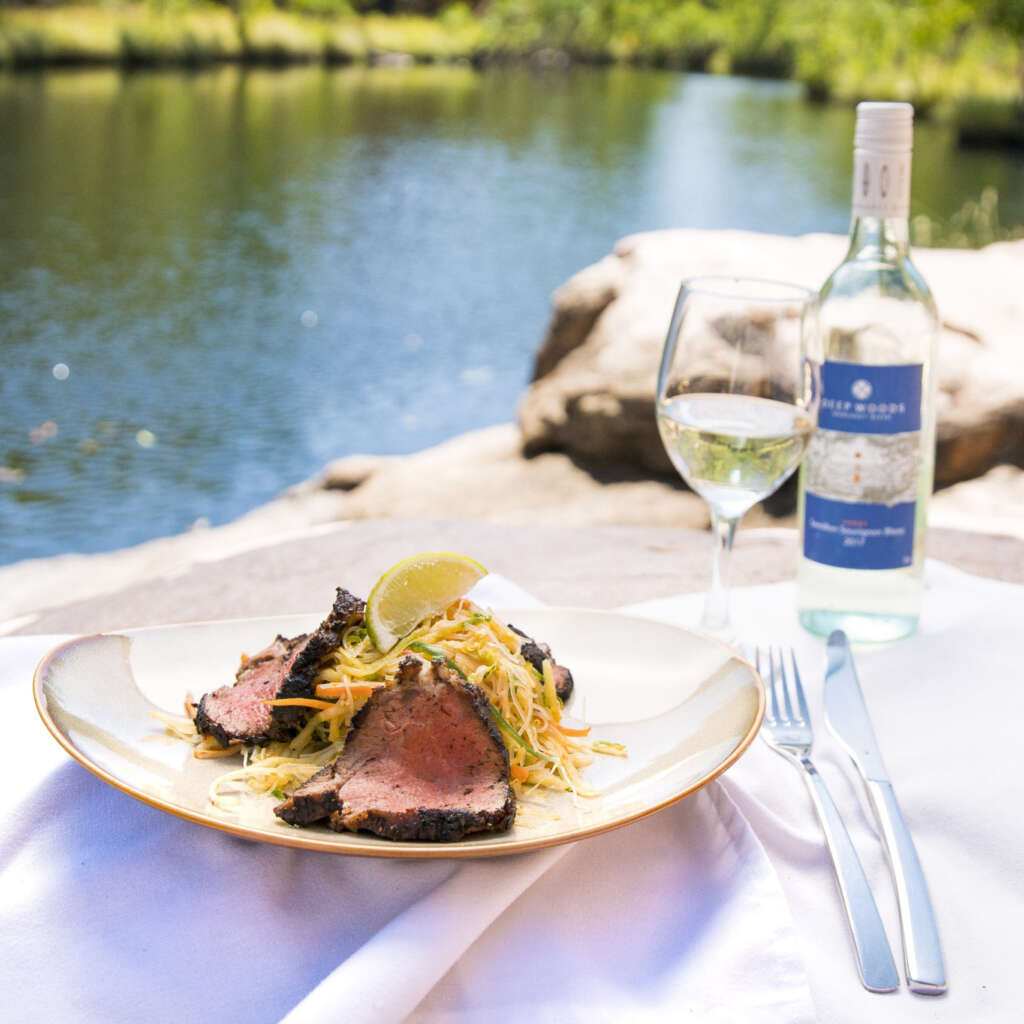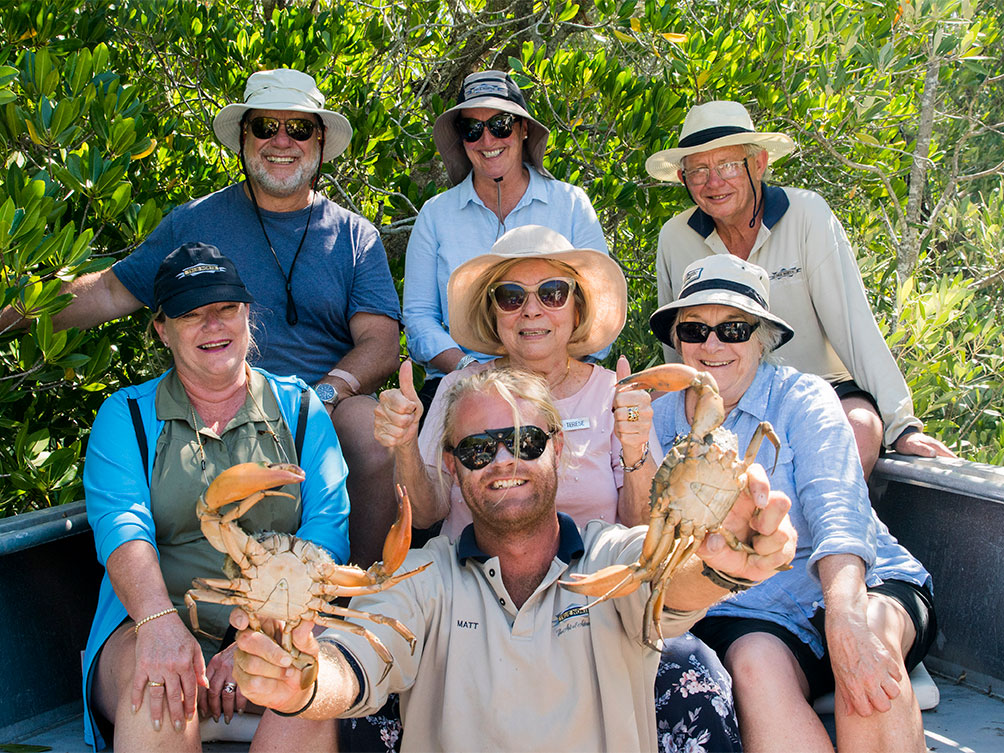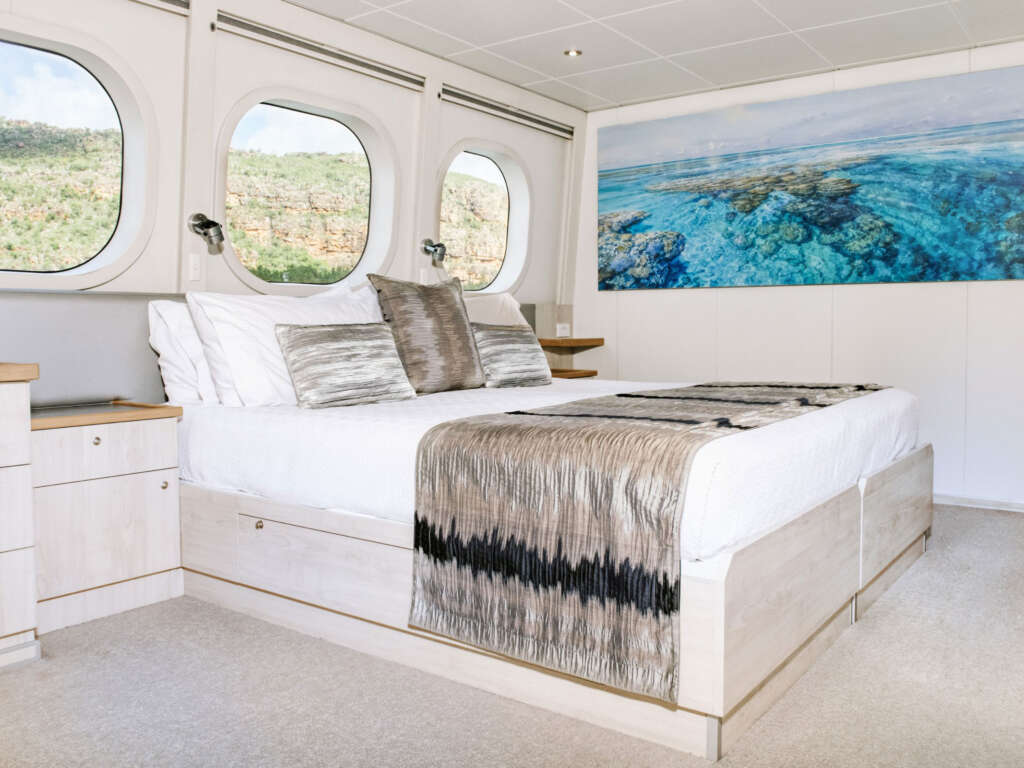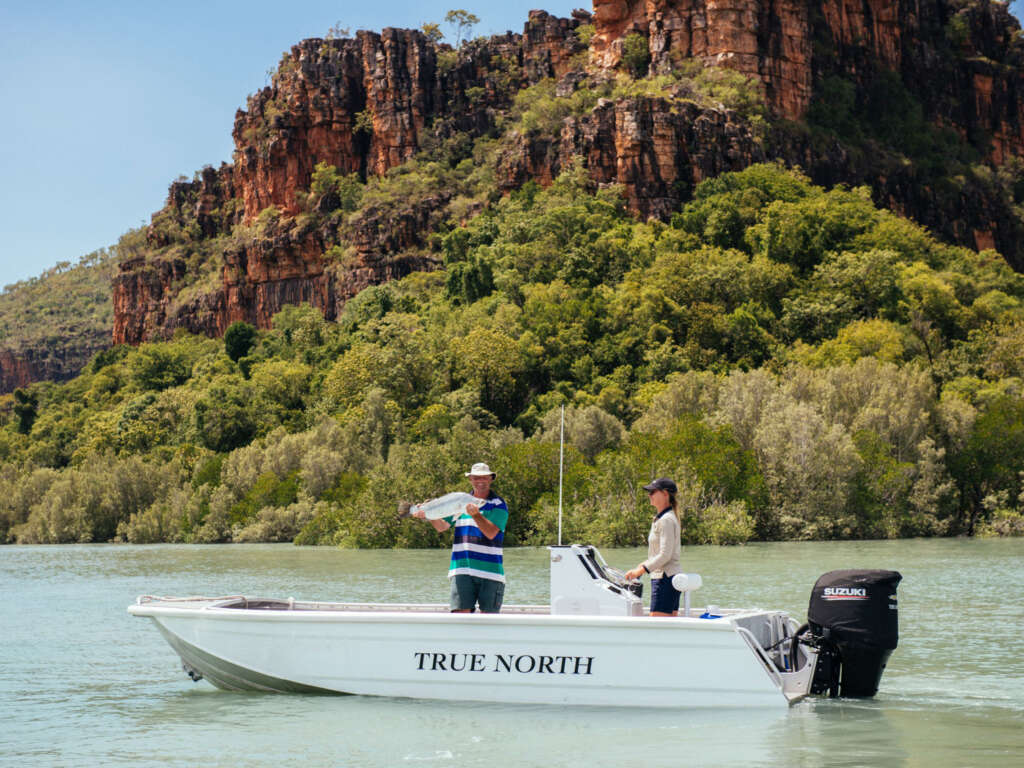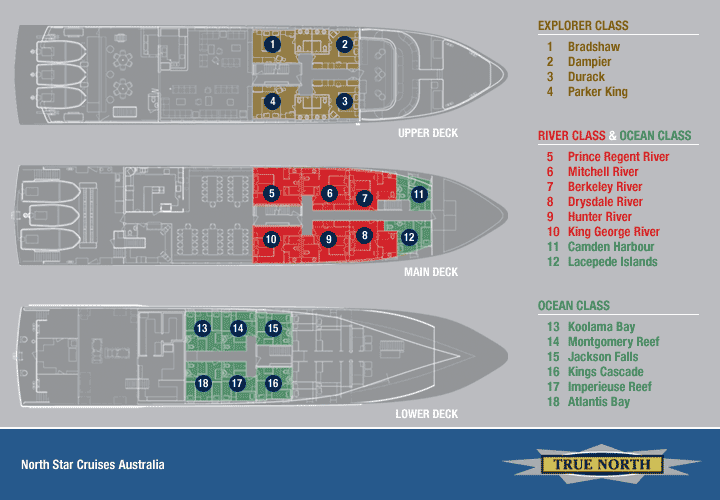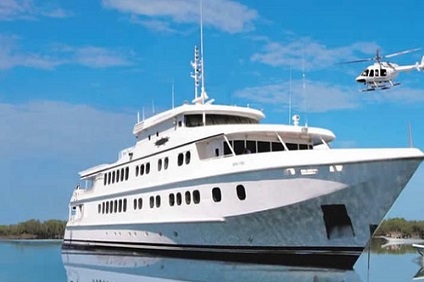
10 nights Cruise-Only
Witness the infamous crocodile initiation ceremony and visit the stilt houses on Lake Kambaraumba. Wander idyllic tropical isles fringed with sandy white beaches and bounded by endless coral reef. Discover Papua New Guinea`s distinctive landscapes – both above and below the water.
_________________
Sepik Soiree Cruise-Only prices include:
– One way charter flight from Cairns to Kavieng
– One way transfer from airport to port
– 10 night small ship adventure cruise aboard True North (36 guests) from Kavieng to Madang
– All shipboard main meals featuring superb fine dining
– All adventure boat excursions
– Non-alcoholic refreshments throughout the day
– All fishing equipment
– Complimentary cafe style coffees and tea are available all day onboard
– Port and Govt taxes
– One way transfer from port to airport
– One way charter flight from Madang to Cairns
Not included:
-Alcohol onboard
-Helicopter flights
This itinerary is provided as example only – prevailing conditions and local arrangements may cause variation. Helicopter flights can be purchased additional to the cruise tariff as a package or individually.
Special Conditions
Special Validity Dates
Cruise Itinerary
| Date | Activity | Arrive | Depart |
|---|---|---|---|
| 03 Nov 2024 | Cairns, Qld, Australia |
Flight to Kavieng | |
| 03 Nov 2024 | Kavieng, New Ireland, Papua New Guinea |
Embark | |
| 04 Nov 2024 | At sea | ||
| 05 Nov 2024 | Vitu (Witu) Islands, Papua New Guinea |
||
| 06 Nov 2024 | Manus Island, Papua New Guinea |
||
| 07 Nov 2024 | Ponam Island, Indonesia |
||
| 08 Nov 2024 | Hermit Islands, Indonesia |
||
| 09 Nov 2024 | Ninigo Islands, Indonesia |
||
| 10 Nov 2024 | Sepik River, PNG |
||
| 11 Nov 2024 | Sepik River, PNG |
||
| 12 Nov 2024 | Bagabag Island, Papua New Guinea |
||
| 13 Nov 2024 | Madang, Papua New Guinea |
Disembark | Flight to Cairns |
| 13 Nov 2024 | Cairns, Qld, Australia |
All itineraries and ports of call at the discretion of the cruise line subject to local weather conditions and may change without notice.

10 Night Cruise sailing from Kavieng to Madang aboard True North.
NOTE: Cruise may operate in reverse – Madang to Kavieng. Please check at time of enquiry/booking.
Sample Itinerary:
Day One
Your “welcome aboard” is in the vibrant city of Cairns. One of our crew members will escort you aboard True North Adventure Cruises’ very own charter aircraft! Now sit back and enjoy the comfortable flight to Kavieng. As soon as you step off the plane you will begin to reshape your impressions of the “land of the unexpected”.
Perhaps the clean and fresh sea breezes will take you by surprise, or will it be the huge smiles of locals so eager to welcome you to their island paradise. After clearing customs, we will transfer you to the on- board luxury of the TRUE NORTH and, the delights of our renowned galley. Enjoy a welcome aboard lunch before we visit a local island resort.
Day Two
The many islands around Kavieng and New Hanova are a cruise highlight. A morning sing sing will be a memorable event as every man, woman and child turns out in welcome. Off the beach we find ships, planes and even submarines wrecked in shallow water and beyond the reef it’s time to encounter a marauder of another kind! And, what a place for diving and snorkeling!
Day Three
The Vitu Islands are a volcanic group with an area of 96 km2 located in the Bismarck Archipelago. Formerly called the French Islands, the group is also sometimes known as the Witu Islands. The islands are volcanic ocean peaks and although they are reef-ringed, they are not atolls and therefore highly fertile. The group is the chief copra centre of Papua New Guinea, although the main crop harvested is now cocoa (due to the depressed prices available for copra). Garove [or Big Witu] and Unea [Bali] are the largest islands.
The islands are situated north west of the Talasea Peninsula on the north coast of New Britain with Unea lying some 40 nautical miles south east of the main group and the remaining islands – Mundua situated 7 miles NW of Garove, and Narage some fifteen miles NW of Mundua. The final extension of the chain being the Attilian Reef which is further NW of Narage and all but totally submerged making it dangerous to shipping.
Narage Island is a post-eruption volcanic remnant measuring just 210,000 m2 – prior to the eruption in 1892-3 it measured more than 600,000 m2! The tsunami from this explosion wiped-out all but two persons in Munda’s lowest-lying village (they were absent on Garove) and was causative to a major population reduction over a wide area on the north coast of New Britain. Narage is now shrouded in forest but not far from the shoreline there is a pool of boiling water, providing evidence of more recent volcanic history. In German colonial times, apart from the Kokopo area, the Vitu’s were the stamping ground and major enterprise of the American- Samoan, Queen Emma, whose manager, a Dane named Peter Hansen, became quite famous for his retinue of concubines, some 26 in number!
When the Germans were expulsed post World War I the island group was acquired by the trading group Burns Philp. Langu Plantation was ceded by Burns Philp to the Coote family after World War II as compensation following the execution of their family head (and Burns Philp store manager) by the Japanese after he refused to give the invaders keys to Burns Philp’s facilities in Rabaul. The Perhafen mission was established inside the caldera which forms the bulk of Garove, a wise choice considering the island’s exposure to sea state – the island comprising at places only the precipitous higher ground of the caldera rim. The helicopter will provide a bird’s eye view of the entire island group whilst the ship’s expedition boats will deliver guests ashore for historical and cultural tours.
And the surrounding reef will lure the fishers, snorkellers and divers.
Vitu’s remote coral reefs remain largely unexplored. Few divers have visited this area and many reefs remain un-dived. The visibility is usually superb and pelagic fishes are abundant. Grey reef sharks, silvertip sharks, dog-tooth tuna, rainbow runners and barracuda are seen on most dives. The fish assemblages on these reefs are distinctly oceanic in composition and a number of species that are rare closer inshore are very abundant here.
“Krakafat” is a dive site of particular note – a sea of schooling barracuda, dog tooth tuna, trevally and everything in between. Other sites worthy of exploration include “Dickies Nob”, “Barneys” and the “Arches” at nearby Ningau Island.
Day Four
This morning we wake in Manus Province – very few travellers make it to this remote part of Papua New Guinea. The province consists of several island groups including the Horno Islands, the Admiralty Islands (including Manus Island), the Hermit Islands, Ninigo Islands and Wuvulu Island. The combined land area of the province is just 2,100 square kilometres however 220,000 square kilometres of sparkling sea surrounds!
Some 45,000 people live within the province boundaries.
The name Manus is a traditional name for a group of fishing people who inhabit the coastal areas of Manus Island. The name differentiates them from other groups with differing customs and languages.
These people were seafarers and traders.
The outstanding feature of their society was individualism and self-reliance. The most cohesive unit was the clan; a number of clans would make up a village, but they retained their separate identities with-in the village. Each clan would have a men’s house which was built by the most powerful person in the clan. Around this would be a number of family houses. Each house was under the protection of a recently deceased male relative whose skull was kept within the house. The spirit of the deceased was potent for as long as good fortune visited the person who gave the skull shelter. The skull was discarded when the spirit was no longer effective.
Apart from this ancestral protection there was no organized religion of worshipping deities. Truth and respect for property were highly valued attributes and it was through the spirits that this code was maintained.
The influence of Christian Missionaries and taking on of ‘western behaviour’ has changed some of these outlooks and customs. Today the dead are buried in communal or private cemeteries.
Change has also come in the form of new commercial pursuits – today the province largely relies on coconut cultivation and bech de mer (sea cucumber) fishing.
The area is renowned for scuba diving and features colourful marine life, coral reefs, shipwrecks, and clear water.
During the morning we visit the island of Rambutyo – the second largest island (after Manus) in the Admiralty Islands. The island lies 40 kilometres to the southeast of Manus and here we hope to encounter traditional garamut (split drum) dancers.
There will also be opportunity for some short walks and, spectacular helicopter flights over the island group.
In the afternoon we will move to the northern end of Rambutyo – the fringing reefs here are amongst some of the most spectacular we see anywhere in PNG with very high coral cover and spectacular walls dropping into deep water. The mosaic of small islands in the area offers a wonderful backdrop and provides a wide range of different habitats to explore. Oceanic currents move gently through the passes allowing us a free ride as we observe the amazing biodiversity of these marine communities.
Sailfish are also caught in the surrounding waters.
Day Five
An entire day devoted to beautiful Ponam Island. Ponam played a major role in World War II. The island was occupied by Japanese forces in 1942 and retaken by Allied forces in 1944. American “Seabees” immediately constructed an airfield which was then handed over to the British Royal Navy.
The British named the airfield HMS Nabaron and used it as a forward operations base. After encountering the enemy, it was not uncommon for damaged aircraft to crash when attempting to land and today the wreckage of several planes can be found in the surrounding waters. Of particular interest is Ensign Jensen’s plane. The naval flyer was the only pilot to report a full-strength Japanese convoy that would have otherwise remained undetected. Unfortunately he was later killed when his plane crashed during a take-off from Ponam and the wreckage can be seen in a lagoon on the east side of the island. The terrestrial remnants of HMS Nabaron should attract the attention of our shore parties whilst the snorkellers will be keen to explore the plentiful bommies and coral outcrops found inside the Manus Barrier Reef. Coral cover is high and brightly coloured butterflyfish and parrotfish are common.
Game fishing for marlin, yellow fin tuna, trevally and mackerel is possible and bottom fishing can produce quality catches of snapper.
Ponam is adjacent to the longest coral reef in Manus Province providing plenty of opportunity for SCUBA diving.
The ship’s helicopter will again swing into action offering a unique prospective of the island’s many lagoons and, nearby Manus Island.
There may even be time for a romantic stroll along your very own beach complete with coconut palms and a shimmering South Pacific sunset.
Day Six
Today we begin to visit a region that was highly rated by the underwater explorer Jean-Michel Cousteau.
The Hermit Islands form a 22 kilometre long barrier reef. They are renowned for their clam gardens and the snorkelling is truly spectacular. The gently sloping reef edge disappears into the blue depths with visibility usually exceeding 40m, allowing us excellent views of the marine life that inhabits the reef edge. Sharks, manta rays, turtles and large schools of barracuda and trevally all reside here along with the usual array of colourful reef fishes and invertebrates. For the divers – The Hermits also feature incredible reef formations where large schools of mobula rays, snapper, trevally and grey reef sharks are encountered! Fresh ocean currents also make for rip-roaring dives in channels chocked with giant sea fans and soft coral formations.
Marlin and sailfish are also known to occur and hopefully the hikers will catch a glimpse of deer introduced by German colonists.
In the afternoon the expedition boats will land at Luf Island – the only inhabited island in the Hermits. Join the crew as we meet the locals and experience local village life.
Day Seven
The Ninigo Islands are a large open-atoll structure surrounded by several smaller atoll formations. In total there are 7 atolls with around 50 small islets – plenty of opportunity for exploration.
The largest component of islands forms a 34 km long by 18 km wide atoll that is open on its western side. The major island within the group is Mal, located at the southern end of the outer reef. Other islands on the reef include: Hepi, Lau, Pelipa, Ahu, Sawapil, Chauch, Menan, Longan, Nahanu, Hepisasa, Chacheon, Maichuch, Potaminam, Amik, Puol, Pisa, Ngi, Onia, Wahangahun, Sabucho, Pihun, Keholl, Kamochin, Sand and Nunu. Within the lagoon are the islands of Pingilap, Talil, Hottom, Bahanat and Amot.
The diving here is some of the best encountered in PNG. We will endeavour to explore as many of these picture-perfect islands as we can and it’s likely that the day will be filled with magical snorkelling and diving experiences, leviathan struggles with rod and reel, exhilarating dips in the crystal clear lagoons and romantic strolls along the ever-present palm fringed beaches.
Days Eight and Nine
The Sepik – as far as adventure is concerned, it doesn’t get much better. Just the name conjures up excitement.
The Sepik River is the longest river in Papua New Guinea and, one of the great river systems of the world. It has a large catchment area and supports numerous landforms including swamplands, tropical rainforests and mountains. Biologically, the river system is possibly the largest uncontaminated freshwater wetland system in the Asia-Pacific region.
The river’s total length is 1,126 kilometres and it has a drainage basin of over 80,000 square kilometres! There is a 5-10 kilometer wide belt of active meanders along most of the river’s course and a floodplain up to 70 kilometers wide includes extensive backwater swamps. However, unlike many other large river systems, the Sepik has no delta – it flows straight into the sea. The entire Sepik basin remains a largely undisturbed environment – there are no major urban settlements or mining and forestry activities in the river catchment.
Local villagers have lived along the river for many millennia and the river has formed the basis for food, transport and culture. European contact with the river started in just 1885 when German colonists first explored the area. In 1886 and 1887, further expeditions by steam boat were conducted by the Germans and over 600 kilometers of riverine was explored. Between 1912 and 1913 the Germans sent further expeditions to explore the river and surrounding areas. They collected flora and fauna, studied local tribes and produced the first maps. The station town of Angoram was established as a base on the lower Sepik for explorations, but with the beginning of World War I, exploration ceased.
After the war the Australian government took trusteeship of the former German colony, creating the Territory of New Guinea. During this period the Australians established a station on the middle Sepik at Ambunti and conducted further exploration.
In 1935 Sir Walter McNicolls, the new administrator of the Territory of New Guinea travelled up length of the Sepik to “have a look at the river people and the kind of country along the banks”.
The Japanese held the area throughout most of the Second World War. By the end of the war the Japanese had been completely surrounded however, the battle to defeat the remaining forces was hard fought and drawn out due to the terrain.
The Australians eventually pushed the Japanese back to the village of Timbunke on the middle Sepik in July 1945. Eventually the Japanese were defeated and surrendered at Wewak in September 1945.
The Sepik is revered for its art. The tribes living along the river produce magnificent wood carvings and artful clay pottery. Many tribes use garamut drums in rituals; the drums are formed from long, hollowed out tree trunks carved into the shape of various totem animals. As part of an elaborate coming of age ceremony, young men are scarified with the image of a crocodile on the river bank.
The TRUE NORTH will arrive at the mouth of the Sepik at first light before proceeding 70 nautical miles upstream. Then it’s away in the expedition boats and the helicopter for days filled with exploration and discovery. First stop is the township of Angoram – here the waterside market presents as a fantastic opportunity to purchase local carvings. At Kambaraumba village we will be greeted by a ‘sing-sing’ featuring giant crocodile puppets that gyrate through crowds of dancers and drummers – truly a feast for the senses! Then explore the maze of swamps and small waterways that lead to Lake Kambaraumba and its stilt village – a community of huts, churches, schools and animal enclosures built above the waters of the lake!
Day Ten
Bagabag Island is a white-sand island offering excellent fishing, snorkelling, and diving.
In the morning the expedition boats will survey the outer-reef which is teeming with fish, turtles and dolphins. The area is also renowned for its endless walls of sea fans, pristine corals and large pelagic species.
The inshore coral will entertain the snorkellers and there will also be relaxed opportunities for swimming and beachcombing on a Bagabag beach.
The ship’s helicopter will also be away again – to explore the sounding area and nearby KarKar Island.
Karkar is a larger oval-shaped volcanic island about 25 km in length and 19 km in width. In the centre of the island there is an active volcano with two nested calderas. The latest eruptions on this island occurred in the 1970s. The island has a relatively large population of approximately 50,000. The two main exports from the island are cacao and coconuts, which can grow in the same soil due to height differences. The large plantations are generally family owned.
After lunch we’ll go ashore to meet the Bagabag islanders – there are just 4 villages here and apparently the locals are keen to introduce visitors to their unique culture and way of life.
The island is rich in betel-nut, local pigs and other food. Life on the island can be quite interesting as there are very few people and they all know each other very well.
Then, you will not be able to resist the charms of Christmas Bay – here we can position the TRUE NORTH within 10 metres of the beach – all ashore for sunset drinks before a farewell dinner to remember!
Day Eleven
This morning we are alongside in Madang. Disembark. Transfer to your charter plane and the return flight to Cairns. We are already looking forward to welcoming you back on-board – the next time you Go Wild in Style!

The TRUE NORTH allows discerning adventurers to experience wilderness in surroundings more akin to one of the world’s most exclusive hotels! Guests are able to take advantage of a number of lavish vantage points including a sundeck, a forward observation lounge, a ship’s lounge and an alfresco bar. The ship’s naturalist presents interpretative information on plasma screens and, an internet café enables convenient communication with the outside world.
A popular venue on any True North cruise, the lower deck dining room offers the ultimate in comfort and uninterrupted vista – large panoramic windows ensure that guests never miss any of the action, even when they are enjoying the ‘finest in fine dining’. All cabins feature stylish décor, en-suite facilities, in-house entertainment and satellite telephones. The Explorer Class staterooms and the River Class cabins offer king size beds that can be converted to singles and the Ocean Class twins feature roomy single beds.
Multiple adventure boats provide guests with greater opportunity to do “what they want, when they want” and, to add yet another dimension to adventure, most cruise options feature an onboard helicopter!The purpose built TRUE NORTH is able to explore the upper reaches of shallow river systems – guests need only step out of their cabins to experience wilderness and, the latest in computer controlled motion stabilizers ensures a comfortable ride.
Ship Profile & Stats
- Length: 50 metres
- Tonnage: 740 tonnes
- Maiden Voyage: 2005
- Passenger Capacity (dbl): 36
- Crew Nationality: Australian
- Officer Nationality: Australian
- Dining Staff Nationality: Australian
- Ship Registration: Australian
Ship Amenities
- All cabins have private ensuited facilities
- Air Conditioning
- In cabin entertainment and satellite telephone
- 240 V and 110 V (normal Australian plugs)
Ship Facilities
- Forward Observation Lounge
- Ships Lounge and Alfresco Bar
- Sports Deck
- Lower Deck Dining Room
- Fully equipped gourmet galley
- 6 x fully surveyed expedition boats
- Most cruise options feature an onboard 5 seater helicopter (Eurocopter Squirrel)
- Internet Cafe

WHY YOU SHOULD CRUISE WITH TRUE NORTH ADVENTURE CRUISES
True North Adventure Cruises is the winner of numerous awards for excellence.
True North Adventure Cruises is an undisputed market leader and offers activity based itineraries especially designed for the most discerning adventurer.
True North Adventure Cruises consistently operates with impeccable customer satisfaction rates.
True North Adventure Cruises pioneered luxury adventure-cruising along the Kimberley coast 30 years previous. Others cannot equal our experience and knowledge!
Explore the magnificent Kimberley coast on either a 7 night, 10 night or 13 night voyage of discovery.
The TRUE NORTH is an Australian registered ship and is not required to exit territorial waters during Australian voyages – every day on-board the TRUE NORTH is an activity day!
The TRUE NORTH is the ONLY adventure-cruise ship in the southern hemisphere that travels with an on-board helicopter – an air conditioned Eurocopter.
The TRUE NORTH features enhanced levels of comfort throughout – allowing guests opportunity to experience wilderness in surroundings more akin to one of the world’s most exclusive hotels.
The TRUE NORTH features several lavish vantage points including a sundeck, an observation lounge, a ship’s lounge, an alfresco bar and a sports deck.
All cabins feature en-suites, in-cabin entertainment and private satellite telephones.
An internet café enables guests to maintain contact with the corporate world.
The TRUE NORTH is purpose built for accessing shallow coastal environs and river systems – bigger ships cannot go where we go!
The TRUE NORTH features computer controlled motion stabilizers.
The TRUE NORTH is fully licensed for fishing activities.
The TRUE NORTH is revered for its on-board dining.
Legendary and authentic service – the TRUE NORTH welcomes just 36 guests and, an AUSTRALIAN crew uniquely chaperones your every experience ensuring our renowned reputation for attention to detail.
Avoid the crowds – we carry 6 dedicated adventure boats (not rubber boats) that provide guests with opportunity to experience wilderness in comfort and, in small groups. We can also make greater provision for guests to do ‘what they want, when they want’!
Experience the destination – our cruises are activity-based and extended periods at sea are specifically avoided. Daily activities include scenic walks, helicopter flights, culture, fishing, snorkelling, picnics, diving, exploring, nature and much, much more! A ship’s naturalist presents entertaining interpretative sessions.
Select the Deck to view detail.
Select the Cabin to view detail.
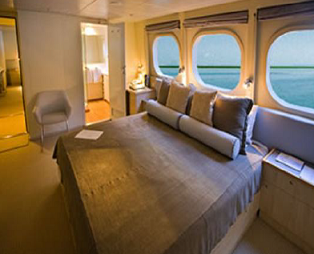
Features:
~Approximate dimensions 3m X 4m (Ensuite 2m X 1.75m)
~King size bed (can be split into singles if requested)
~2 large viewing windows in the main cabin area
~Private spacious ensuite featuring double basin and windows
~Original Windram artwork in the cabin
~Plenty of drawer and closest space to store clothing and other personal items
~Mini Fridge
~Writing desk and chair
~In house entertainment featuring a large plasma TV & DVD player
~Personal air conditioning unit
~Satellite phone
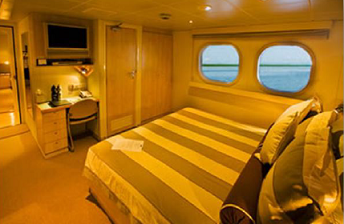
Features:
~Approximate dimensions 3.5m x 3.5m (Ensuite 2m x 1.75m)
~King size bed (can be split into singles if requested)
~Private spacious ensuite featuring windows
~2 Large viewing windows in the main cabin area
~Plenty of drawer and closet space to store clothing and other personal items
~In house entertainment featuring a plasma TV & DVD player
~Personal air conditioning unit
~Satellite phone
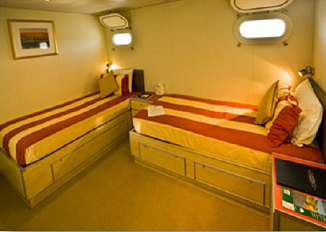
Features:
~Approximate dimensions 2.5m to 3m x 3m (Ensuite 1.5m x 1.75m)
~Twin single beds
~Private Ensuite with spacious shower
~2 oval port holes allowing plenty of natural light into the cabin
~Drawers and closet space to store clothing and other personal items
~In house entertainment featuring a plasma TV & DVD player
~Personal air conditioning unit
~Satellite phone
* Unless otherwise noted all pricing is on a per person twin share basis. All prices based on cash payment - credit card fees may apply. Cruise deposit, amendment and cancellation conditions apply. Special conditions may apply - please ask for full details at time of enquiry. All passports, vaccinations and visas are the responsibility of the travelling guest to secure prior to departure from Australia. Any pricing not in Australian Dollars will be converted on the day of payment into the relevant currency based on our daily rate of exchange. Please note that many of the prices shown on this website are not shown in real time. Whilst we endeavour to keep our pricing as up-to-date as possible, the advertised prices shown here may differ slightly from the live prices in our booking system. All pricing and offers are subject to availability at time of booking. Whilst all information is correct at the time of publication, offers are subject to change. We reserve the right to correct errors without penalty. Please submit any data errors/omissions you may notice on this site.
Unless otherwise expressly noted, all materials, including images, illustrations, designs, icons, and photographs appearing anywhere on this website are protected by worldwide copyright laws and treaty provisions. The copyright on such materials is held by the original creator of the materials. None of the materials may be copied, reproduced, displayed, modified, published, uploaded, posted, transmitted or distributed in whole or in part in any form or by any means other than as provided by Cruise Factory and Cruise Traveller to its clients, or with the prior written permission of Cruise Factory and Cruise Traveller. All rights not expressly granted in these Terms are reserved. Any unauthorised use of the materials appearing on this website may violate copyright, trademark and other applicable laws and could result in criminal or civil penalties.



